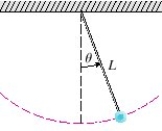Multiple Choice
The figure shows a pendulum with length L and the angle from the vertical to the pendulum. It can be shown that , as a function of time, satisfies the nonlinear differential equation where we can use the linear approximation 
A)
B)
C)
D)
E)
Correct Answer:

Verified
Correct Answer:
Verified
Related Questions
Q1: A spring with a <span
Q2: Solve the initial value problem.
Q4: A series circuit consists of a
Q5: Solve the differential equation. <span
Q6: Suppose a spring has mass M
Q7: A spring with a mass of
Q8: A spring with a 3-kg mass
Q9: Solve the initial-value problem. <span
Q10: A series circuit consists of a
Q11: Solve the differential equation using the